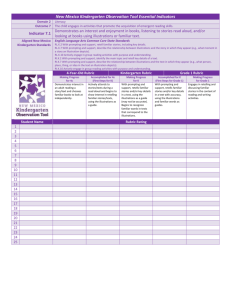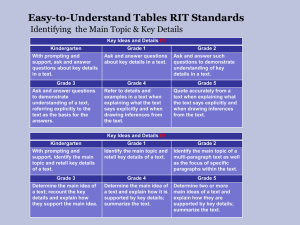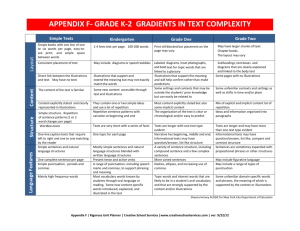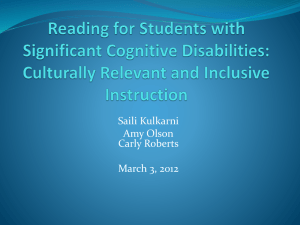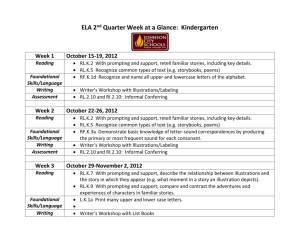0KGrade Learning Targets - Whittier City School District
advertisement
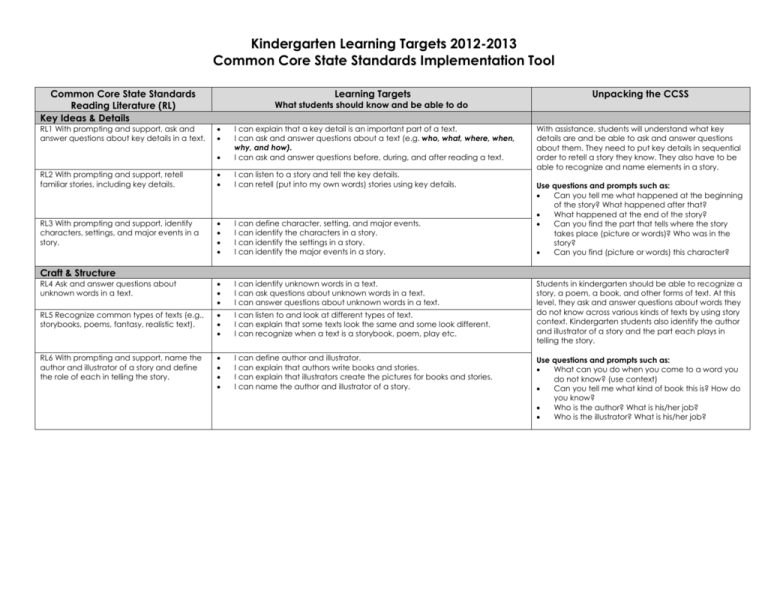
Kindergarten Learning Targets 2012-2013 Common Core State Standards Implementation Tool Common Core State Standards Reading Literature (RL) Key Ideas & Details Learning Targets Unpacking the CCSS I can explain that a key detail is an important part of a text. I can ask and answer questions about a text (e.g. who, what, where, when, why, and how). I can ask and answer questions before, during, and after reading a text. RL2 With prompting and support, retell familiar stories, including key details. I can listen to a story and tell the key details. I can retell (put into my own words) stories using key details. With assistance, students will understand what key details are and be able to ask and answer questions about them. They need to put key details in sequential order to retell a story they know. They also have to be able to recognize and name elements in a story. RL3 With prompting and support, identify characters, settings, and major events in a story. I can define character, setting, and major events. I can identify the characters in a story. I can identify the settings in a story. I can identify the major events in a story. RL4 Ask and answer questions about unknown words in a text. I can identify unknown words in a text. I can ask questions about unknown words in a text. I can answer questions about unknown words in a text. RL5 Recognize common types of texts (e.g., storybooks, poems, fantasy, realistic text). I can listen to and look at different types of text. I can explain that some texts look the same and some look different. I can recognize when a text is a storybook, poem, play etc. RL6 With prompting and support, name the author and illustrator of a story and define the role of each in telling the story. I can define author and illustrator. I can explain that authors write books and stories. I can explain that illustrators create the pictures for books and stories. I can name the author and illustrator of a story. RL1 With prompting and support, ask and answer questions about key details in a text. What students should know and be able to do Use questions and prompts such as: Can you tell me what happened at the beginning of the story? What happened after that? What happened at the end of the story? Can you find the part that tells where the story takes place (picture or words)? Who was in the story? Can you find (picture or words) this character? Craft & Structure Students in kindergarten should be able to recognize a story, a poem, a book, and other forms of text. At this level, they ask and answer questions about words they do not know across various kinds of texts by using story context. Kindergarten students also identify the author and illustrator of a story and the part each plays in telling the story. Use questions and prompts such as: What can you do when you come to a word you do not know? (use context) Can you tell me what kind of book this is? How do you know? Who is the author? What is his/her job? Who is the illustrator? What is his/her job? Kindergarten Learning Targets 2012-2013 Common Core State Standards Implementation Tool Integration of Knowledge & Ideas RL 7 With prompting and support, describe the relationship between illustrations and the story in which they appear (e.g., what moment in a story an illustration depicts). RL 8 (Not applicable to literature) RL 9 With prompting and support, compare and contrast the adventures and experiences of characters in familiar stories. I can look at the illustrations in a story and describe what I see. I can identify the part of a story shown by the illustration. I can explain how illustrations help me understand a story. I can identify the characters in stories I read or hear. I can describe the adventures and experiences of characters in a story. I can tell how the adventures and experiences of characters are alike? I can tell how the adventures and experiences of characters are different? With assistance, students will understand the relationship between illustrations and the story and how the illustrations help explain the story. Students will look for similarities and differences in characters‟ experiences within stories they know. Use questions and prompts such as: Look at the picture. Can you tell me what is happening in the story? How does the picture help you? What is the same about the characters in the two stories? What is different? How did the characters solve the problem in the two stories? Did they solve the problem in the same way? Range of Reading and Level of Text Complexity RL10 Actively engage in group reading activities with purpose and understanding. a. Activate prior knowledge related to the information and events in texts. b. Use illustrations and context to make predictions about text. I can follow the rules my teacher gives for listening. I can listen by facing the speaker, sitting still, and making eye contact. I can ask and answer questions about what is being read. I can use the pictures to think about what will happen next in the story. I can use what I already know to make predictions about what I will learn. “The Reading standards place equal emphasis on the sophistication of what students read and the skill with which they read. Standard 10 defines a grade-by-grade „staircase‟ of increasing text complexity that rises from beginning reading to the college and career readiness level. Whatever they are reading, students must also show a steadily growing ability to discern more from and make fuller use of text including making an increasing number of connections among ideas and between texts, considering a wider range of textual evidence, and becoming more sensitive to inconsistencies, ambiguities, and poor reasoning in texts.” “Students also acquire the habits of reading independently and closely, which are essential to their future success.” Students should encounter appropriately complex texts at each grade level in order to develop the mature language skills and the conceptual knowledge needed for success in school and life. Effective scaffolding should allow the reader to encounter the text with minimal clarifications. It should not replace the text by translating its contents for students. Kindergarten Learning Targets 2012-2013 Common Core State Standards Implementation Tool Common Core State Standards Reading Literature (RI) Key Ideas & Details Learning Targets Unpacking the CCSS What students should know and be able to do RI1 With prompting and support, ask and answer questions about key details in a text. I can explain that a key detail is an important part of a text. I can ask and answer questions about the key details of a text (e.g. who, what, where, when, why, how.) I can ask and answer questions before, during and after reading a text. RI2 With prompting and support, identify the main topic and retell key details of a text. I can define main topic (who or what the text is mostly about). I can identify the main topic of a text. I can retell the key details of a text. RI3 With prompting and support, describe the connection between two individuals, events, ideas, or pieces of information in a text. I can identify individuals, events, ideas, or pieces of information in a text. I can describe a connection between two individuals in a text (e.g. Clifford is Emily Elizabeth’s dog) I can describe a connection between two events in a text. (The Pilgrims come to America; the first Thanksgiving is celebrated). I can describe a connection between two ideas or pieces of information in a text (e.g. The sun and the moon are both in the sky). With assistance, students will understand what key details are and be able to ask and answer questions about them. They should be able to state the main idea in their own words. At this level, students are required to tell how two individuals, events, ideas or information are linked together. Use questions and prompts such as: Using what you read, write (dictate or draw) or ask your own questions about an important idea from this text. What is the main idea of this text? Can you find one of the important ideas in this text? Can you find another important idea? Can you tell me how these two ideas are the same? Can you tell me how they are different? Craft & Structure RI4 With prompting and support, ask and answer questions about unknown words in a text. I can identify words I do not know in a text. I can ask questions about words I do not know in a text. I can answer questions about words I do not know in a text. RI5 Identify the front cover, back cover, and title page of a book. I can identify the front cover and back cover of a book. I can explain that a title page is inside of a book. I can identify the title page of a book. RI 6 Name the author and illustrator of a text and define the role of each in presenting the ideas or information in a text. I can define author and illustrator. I can explain that authors write texts. I can explain that illustrations create the pictures for texts. I can name the author and illustrator of a text. With assistance, students should understand how a piece of informational text is structured. At this level, students ask and answer questions about words they do not know; they can identify the main print concepts/features of a book and understand the roles of both author and illustrator. Use questions and prompts such as: What do you do when you come to a word you do not know? What can help you? (glossary, use context) What is the job of the author? What is the job of the illustrator? Show me the front of the book. Show me the back of the book. Kindergarten Learning Targets 2012-2013 Common Core State Standards Implementation Tool Integration of Knowledge & Ideas RI7 With prompting and support, describe the relationship between illustrations and the text in which they appear (e.g., what person, place, thing, or idea in the text an illustration depicts). I can look at the illustrations in a text and describe what I see? I can identify the part of a text shown by the illustration. I can explain how illustrations help me understand a text. RI8 With prompting and support, identify the reasons an author gives to support points in a text. RI9 With prompting and support, identify basic similarities in and differences between two texts on the same topic (e.g., in illustrations, descriptions, or procedures). I can identify why an author wrote a text. I can identify the points an author makes in a text. (Everyone should recycle) I can identify the author’s reasons to support main points. (Everyone should recycle because landfills are becoming full). I can identify how two texts on the same topic are alike. I can identify how two texts on the same topic are different. With assistance, students will understand how illustrations help explain the text and discuss similarities and differences in two texts that share the same main idea. At this level, students should also develop the ability to recognize the author’s reasoning by finding support within the text. Use questions and prompts such as: Look at this picture. Can you tell how the author uses this picture to help you understand the topic? What does this picture add to your thinking about what you (we) read? Can you find the reason why the author thinks that...? Can you find the reason why the author believes...? How are these two books showing the same topic in different ways? Range of Reading and Level of Text Complexity RI10 Actively engage in group reading activities with purpose and understanding. a. Activate prior knowledge related to the information and events in texts. b. Use illustrations and context to make predictions about text. I can follow the rules my teacher gives for listening. I can listen by facing the speaker, sitting still, and making eye contact. I can ask and answer questions about what is being read. I can use the pictures to think about what will happen next in the story. I can use what I already know to make predictions about what I will learn. “The Reading standards place equal emphasis on the sophistication of what students read and the skill with which they read. Standard 10 defines a grade-by-grade „staircase‟ of increasing text complexity that rises from beginning reading to the college and career readiness level. Whatever they are reading, students must also show a steadily growing ability to discern more from and make fuller use of text including making an increasing number of connections among ideas and between texts, considering a wider range of textual evidence, and becoming more sensitive to inconsistencies, ambiguities, and poor reasoning in texts.” “Students also acquire the habits of reading independently and closely, which are essential to their future success.” Students should encounter appropriately complex texts at each grade level in order to develop the mature language skills and the conceptual knowledge needed for success in school and life. Effective scaffolding should allow the reader to encounter the text with minimal clarifications. It should not replace the text by translating its contents for students. Kindergarten Learning Targets 2012-2013 Common Core State Standards Implementation Tool
